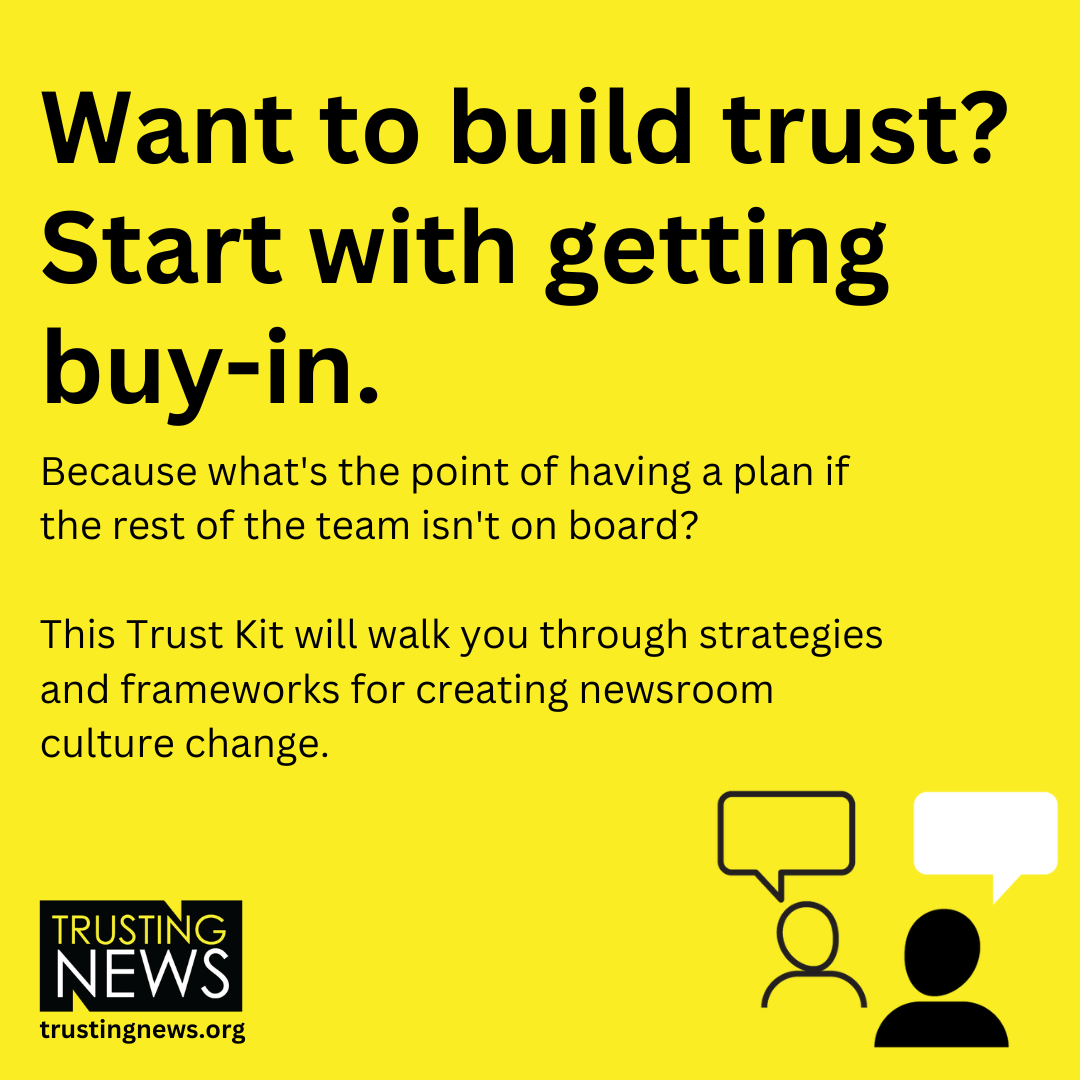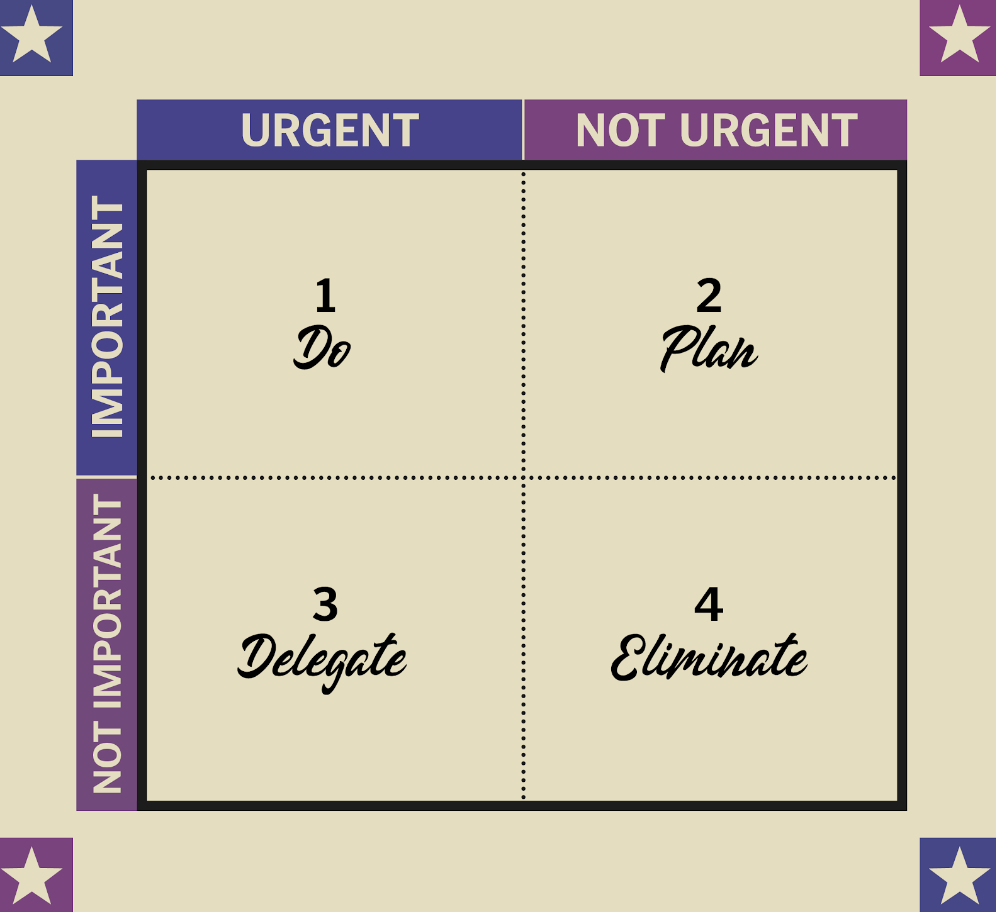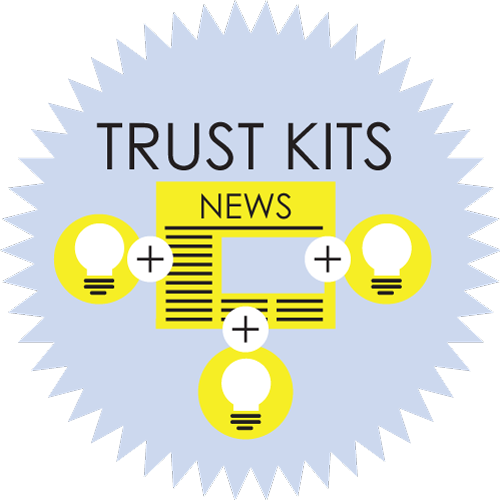Newsroom Culture
Getting buy-in for trust work
We know many journalists care deeply about being trustworthy and seen as a credible, relevant source of information to their communities. We also know building trust takes time and shifts in workflows, something we know is challenging.
In a recent community survey of the Trusting News audience, we asked journalists what the biggest obstacles were when trying to implement trust strategies in their news organizations. The main reasons journalists cited for not doing trust work were the lack of time, followed by newsroom culture, and not being supported or having buy-in to do the work (from management or fellow colleagues.)
When we talk about building trust, what we’re proposing is a new way to produce journalism that has transparency and engagement strategies at its core. And anytime you ask journalists to change habits and routines, it involves reprioritizing, which means changing organizational values and culture.
We know this sort of reprioritization is not easy, so we created this Trust Kit to help walk you through tools, strategies and frameworks for how to create culture change. Some of the tips might work best for you if you’re in a management role and some are more about peer-to-peer collaboration.
When we talk about building trust, we’re proposing a new way to do journalism. And anytime you ask journalists to change habits and routines, it involves reprioritizing, which means changing values and culture.

Goals
This Trust Kit helps you:
- Learn what’s needed to create change in a newsroom
- Learn how journalists can reset newsroom priorities
- Identify your influence in the newsroom
- Determine what kind of help you need from colleagues
- Learn strategies for getting buy-in and implementing something new


What does culture change involve?
The American Press Institute, a parent organization of Trusting News, has done a lot of work related to newsroom culture and what it takes to shift culture. In a report on the topic, they note culture is often defined by the newsroom’s leadership and then fulfilled by staff. It takes a set of expectations, values, motivations, and purposes.
You might’ve seen a similar formula before.
![]()
You can have any of these elements on their own. (Many journalists probably feel dissatisfaction with certain parts of their job.) But in order to see actual change you need to have all three of these elements – including a shared vision and process for how the organization will shift and move forward.
As you think about what this process of moving forward looks like, we invite you to reflect on two important elements.
First: Think about what type of buy-in you need
Newsroom culture is a team sport. The dynamics within a news organization are co-created by all journalists involved, and we depend on one another and need people on board in order for the organization to function and work.
This means if we want things to change, we won’t be able to do it on our own. It will take some sort of involvement from your colleagues.
Before laying out a plan for culture change, we invite you to think through what you might need from your colleagues.
It could be…
- Permission: Allow me to do it
- Support: Don’t get in the way as I do it
- Cooperation: Help me do it
- Adoption: Join me in doing it even if I’m not involved
- Validation: Reward me for having done it
The plan you develop will greatly depend on what you need from your colleagues. (Keep scrolling this Trust Kit for tips on getting buy-in from colleagues.)
Second: Think about prioritization
With never-ending to-do lists and shrinking newsroom staff, we’re often bumping up against a lack of time and staffing capacity. So we have to prioritize and we may have to choose not to do some things. Look at the tasks in front of you, and prioritize them based on what’s most important and urgent, and leave the less important and less urgent things lower on the priority list. (The below Eisenhower Matrix can help with visualizing this!)
- If something is urgent and important, do it first.
- If something is important, but not urgent, schedule time for it.
- If something isn’t important, ask: Why are you doing it? If it must be done, delegate as much as possible. Otherwise, don’t do it.

Photo courtesy of Developing Good Habits/Sara O’Brien

Strategies for culture change
Here are some tips and strategies we recommend as you try to shift newsroom culture. Click or tap each blue box to expand each of the below sections.
Establish what needs to change and why (Tie it to your mission)
Start by articulating clearly what the problem is. That might be the fact that trust in news is low in general. But more compelling is likely feedback you hear in your own newsroom. What do people distrust about *your* work? What do they complain about? What do they misunderstand or misassume? (Feel free to pull from this deck of research on trust, or from our newsletter archive of challenges and strategies.) The important thing is to be crystal clear about how what you’re proposing matters. For inspiration, take a look at your organization’s mission statement. See if you can tie your goals to your overall established purpose. (Bosses tend to appreciate that.)
Show how the change can help solve your colleagues’ problems
Solving your boss’s problems is a good idea. What is she worried or frustrated about? And what frustrates your coworkers? Showing how you can ease colleagues’ workload or alleviate their tension is WAY more compelling than asking them to make time for something just because it’s a good idea. Are they worried about revenue and how to drive subscriptions? Do they wish they had an easy way to respond to attacks on their credibility? Are they flummoxed by how confused people seem about the difference between news and opinion? Show how working with you could help. Another strategy is to tie it to other, ongoing initiatives. How can trust strategies connect to growing the audience of a newsletter product? Explaining changes in crime coverage? Look for other current or planned projects to attach trust to.
Invest in new routines and staff trainings
We’ve all been part of new initiatives in newsrooms that have quickly dissipated or fallen off people’s radars. To avoid this, when introducing any sort of change in workflow, make sure there’s a follow-up and support plan in place. New routines won’t happen without investment, so plan out how you’ll continue to invest in helping staff understand any new ideas or processes, and offer plenty of opportunities for people to reach out with questions or ask for help.
Talk up your successes, and reward people for them
Keep track of what you do. Save links and screen grabs. Copy language you use in responding to emails and comments. As you do that, make notes about your process. How much time did things take? How do you know it made a difference or was worth your effort? Then find the right avenue to share the work with your colleagues. Maybe that’s a Slack channel designed for brags or kudos. Maybe it’s a newsroom meeting. Maybe the boss sends out a weekly email with highlights of good work. Be ready to share what you tried to do to build trust, how you worked it into your workflow and how you know it was worth the effort.
Start with things you can control
Think about what’s within your sphere of influence. What behind-the-scenes information could you start adding to your stories? How could you be present in responding to user comments? What habits could you adopt with your own sources? What FAQ could you write about coverage you’re connected to? Start by showing what’s possible in ways that might involve getting permission but don’t require other action from colleagues.
Recruit allies and ignore detractors
Only some people are going to think this work is worthwhile, and that’s okay. Don’t try to convert the cranky colleague who thinks he should be able to do things the same way he always had, and people should automatically find it credible and thank him for it. Instead, find collaborators. Maybe it’s a beat or team that’s ready to correct audience misperceptions of their work. Maybe it’s a reporter who’s always up for new ideas. Maybe it’s a weekend social producer who wants to feel empowered to respond to comments. Maybe it’s your direct boss who’s willing to give you the room to experiment. Focus on them, and let the dissenters be someone else’s problem.
Give yourself accountability and structure
Good intentions don’t stand much of a chance against the sometimes grueling hours and non-stop pace of many journalists’ jobs. Think about how you will build time for working on trust, even when it doesn’t tie to your most urgent deadlines. What accountability and structure would be useful? Can you block off 30 minutes a week? Or try telling your boss that you have a goal of doing something new with one story or one shift a week. Think about mapping out the steps to get something done, then give yourself deadlines. And if a nudge from the Trusting News team would be helpful, let us know! Just tell us when to email you and what you’re working on.
Invite your community to hold you accountable
There’s nothing like external pressure to help hold you accountable. It’s great to give yourself accountability within the newsroom, but we highly recommend you talk publicly about changes your newsroom is making (when appropriate to do so.) Remember people won’t notice you’re trying to do anything differently or won’t give you credit for trying to be ethical and careful in your reporting – that is, unless you tell them. So tell your audience how you’re working to do this, and then continue to keep them updated and let them know how initiatives are going. This Trust Kit on transparency has lots of ideas of how you can do this, including examples of how you can share internal changes like this publicly to build trust.

Make it efficient (and act on what you hear)
We know how hard it is to squeeze new things into the jam-packed schedule of a journalist. So, how can you invest in making engagement work more efficient over time? Here are some ideas and tips. (We have some additional tips for making engagement efficient at the bottom of this Trust Kits on moderating comments.)
- Take one-on-one communication public. Think about the time you spend answering emails, having phone conversations and talking to people in person. Then look for chances to share publicly what you’ve already articulated individually.
- Save responses to use again. The best way to build efficiency is to stop crafting the same language over and over. Start a newsroom document where you collect language you use to respond to your community. A Slack channel can also work if that’s more your newsroom’s style.
- Turn responses into content. If you’re investing in responding to comments or users in any format, take those responses and repurpose them as editor’s columns, newsletter sections, social media videos, editor’s notes on stories, etc.
- Form realistic habits that are appropriate for your role. Identify what is within your control and what you hope to accomplish. Comment more on stories? Have better conversations with sources out in the field? Use your own social media to talk about your work? Then set up a system that works for you.
- Make sure the newsroom knows about all of these efforts. Talk about how much time they took, and how much time they saved. Find the right routine (on Slack? In a weekly staff meeting?) to celebrate engagement wins and remind people they’re invited to also share any language you’ve taken public. Remind them how much they can learn from engaging more proactively with the community.

Be upfront that this work takes effort
There’s no denying that you (and we!) are asking journalists to make room in their busy work days to think about something they might not be used to thinking about. Or to find precious minutes for tasks that weren’t already on their to-do list and might not feel essential. But we make time for what we prioritize, and trust is mission-critical. While it does take time, effort and commitment, some of this trust work can actually save time in the long run. Once you’re on the record with your goals, policies and values, linking to them is a lot faster than writing them out from scratch. Find more tips for how to create efficiency within your engagement strategies in this post.
Also, take a moment to congratulate yourself for getting this far! We know taking the steps to earn trust isn’t always simple or easy, especially when it comes to culture change.
Any progress you make on implementing strategies in this Trust Kit should be celebrated as a win! If you find yourself getting stuck, need help brainstorming, or have completed the work in a Trust Kit and would like our team to review and give additional advice, reach out to us at info@trustingnews.org or send us a message on Twitter.
This Trust Kit was last updated May 28, 2023.
